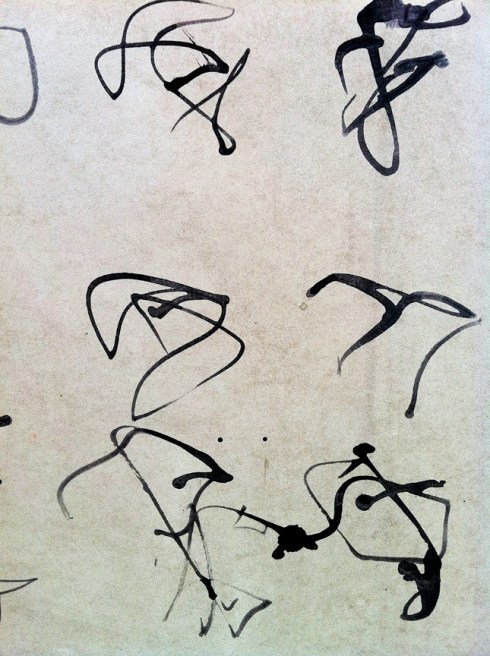
Installation view: Brice Marden at Matthew Marks Gallery
Currently on view in New York: Brice Marden at Matthew Marks Gallery. The show includes large works and drawings, with a smaller exhibit of older pieces next door. The range of these bodies of work—the gestural and transparent fluidity of the later work in contrast to the exquisitely inviolate opaque surfaces from 30 years ago—swings a viewer’s body from one end of the exquisite painterly experience to the other.
And I’m never not moved by seeing his work, from any era.
“They’re like the skeletons of my early paintings,” said Marden in describing the cursive, calligraphic-like paintings.
From an essay by David Rimanelli:
As a metaphor…the skeleton dramatizes the temporal ambiguity built into Marden’s cryptic statement, in which he suggests that only now is he uncovering the skeletal underpinning to his prior practice. The web of associations quickly growing thick and tangled, we move backward and forward over crisscrossing axes of meaning: in a bit of metaleptic time travel, the later work becomes the precursor for the early work. Living/dead, early/late, monochrome/calligraphy: the solidus seems rather tenuous with respect to these binarisms.
If the recent work is the skeleton, then it follows that the ’60s and ’70s is the living body. Few critics have failed to note the intense materiality of those patiently built-up oil-and-wax surfaces, of which Douglas Crimp as said, “The precise characteristic of this material is opacity, of an extremely dense, mat surface; its sense of material qua material is so strong that on last seeing an exhibition of Marden’s painting I felt compelled to walk up to a work and smell it.”
Oh do I know that compulsion…



Deborah – Those paintings in the image at the top of your post – Do they have the opaque-style paintings at the sides of the drawing-style paintings? I didn’t see anything like them on the Matthew Marks site. I wondered if it was an attempt to unite the two different directions.
Thanks,
Nancy
Nancy, the opaque edges of these larger pieces do not have that older style oil/wax opacity but they are definitely in contrast to the highly diluted line quality of these large paintings. But as for his intentions in uniting these styles, I really can’t say. Question for Mr. Marden himself?